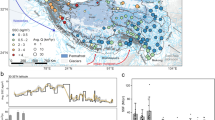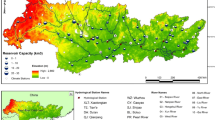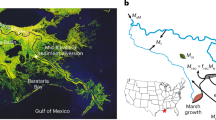Abstract
The erosion, transport and redeposition of sediments shape the Earth’s surface, and affect the structure and function of ecosystems and society1,2. The Yellow River was once the world’s largest carrier of fluvial sediment, but its sediment load has decreased by approximately 90% over the past 60 years3. The decline in sediment load is due to changes in water discharge and sediment concentration, which are both influenced by regional climate change and human activities. Here we use an attribution approach to analyse 60 years of runoff and sediment load observations from the traverse of the Yellow River over China’s Loess Plateau — the source of nearly 90% of its sediment load. We find that landscape engineering, terracing and the construction of check dams and reservoirs were the primary factors driving reduction in sediment load from the 1970s to 1990s, but large-scale vegetation restoration projects have also reduced soil erosion from the 1990s onwards. We suggest that, as the ability of existing dams and reservoirs to trap sediments declines in the future, erosion rates on the Loess Plateau will increasingly control the Yellow River’s sediment load.
This is a preview of subscription content, access via your institution
Access options
Subscribe to this journal
Receive 12 print issues and online access
$259.00 per year
only $21.58 per issue
Buy this article
- Purchase on Springer Link
- Instant access to full article PDF
Prices may be subject to local taxes which are calculated during checkout



Similar content being viewed by others
References
Syvitski, J. P. M. Supply and flux of sediment along hydrological pathways: Research for the 21st century. Glob. Planet. Change 39, 1–11 (2003).
Walling, D. E. The Impact of Global Change on Erosion and Sediment Transport by Rivers: Current Progress and Future Challenges (UNESCO, 2009).
Yu, Y. et al. New discharge regime of the Huanghe (Yellow River): Causes and implications. Cont. Shelf Res. 69, 62–72 (2013).
Beechie, T. J. et al. Process-based principles for restoring river ecosystems. Bioscience 60, 209–222 (2010).
Syvitski, J. P. M. & Kettner, A. Sediment flux and the Anthropocene. Phil. Trans. R. Soc. A 369, 957–975 (2011).
Walling, D. E. & Fang, D. Recent trends in the suspended sediment loads of the world’s rivers. Glob. Planet. Change 39, 111–126 (2003).
Syvitski, J. P. M., Vörösmarty, C. J., Kettner, A. J. & Green, P. Impact of humans on the flux of terrestrial sediment to the global coastal ocean. Science 308, 376–380 (2005).
Montgomery, D. R. Soil erosion and agricultural sustainability. Proc. Natl Acad. Sci. USA 104, 13268–13272 (2007).
Giosan, L., Syvitski, J., Constantinescu, S. & Day, J. Climate change: Protect the world’s deltas. Nature 516, 31–33 (2014).
Wang, H. J. et al. Stepwise decreases of the Huanghe (Yellow River) sediment load (1950–2005): Impacts of climate change and human activities. Glob. Planet. Change 57, 331–354 (2007).
Wang, H. J. et al. Recent changes in sediment delivery by the Huanghe (Yellow River) to the sea: Causes and environmental implications in its estuary. J. Hydrol. 391, 302–313 (2010).
Xu, J. X. Effect of human activities on overall trend of sedimentation in the lower Yellow River, China. Environ. Manage. 33, 637–653 (2004).
Fu, B. J. Soil erosion and its control in the Loess Plateau of China. Soil Use Manage. 5, 76–82 (1989).
Wang, D. & Hejazi, M. Quantifying the relative contribution of the climate and direct human impacts on mean annual streamflow in the contiguous United States. Water Resour. Res. 47, W00J12 (2011).
Liang, W. et al. Quantifying the impacts of climate change and ecological restoration on streamflow changes based on a Budyko hydrological model in China’s Loess Plateau. Water Resour. Res. 51, 6500–6519 (2015).
Miao, C. Y., Ni, J. R. & Borthwick, A. G. L. Recent changes in water discharge and sediment load of the Yellow River basin, China. Prog. Phys. Geogr. 34, 541–561 (2010).
Liu, X. Y. et al. Response of sediment yield to vegetation restoration at a large spatial scale in the Loess Plateau. Sci. China Tech. Sci. 57, 1482–1489 (2014).
Liu, X. Y. et al. Influences of shrubs-herbs-arbor vegetation coverage on the runoff based on the remote sensing data in Loess Plateau. Acta Geogr. Sin. 69, 1595–1603 (2014).
Feng, X. M., Fu, B. J., Lu, N., Zeng, Y. & Wu, B. F. How ecological restoration alters ecosystem services: An analysis of carbon sequestration in China’s Loess Plateau. Sci. Rep. 3, 2846 (2013).
Chen, Y. et al. Balancing green and grain trade. Nature Geosci. 8, 739–741 (2015).
Liu, X. Y. et al. Analysis on sediment yield reduced by current terrace and shrubs-herbs-arbor vegetation in the Loess Plateau. J. Hydraul. Eng. 45, 1293–1300 (2014).
Wang, Y. F., Fu, B. J., Chen, L. D., Lü, Y. H. & Gao, Y. Check dam in the Loess Plateau of China: Engineering for environmental services and food security. Environ. Sci. Technol. 45, 10298–10299 (2011).
Wang, Q. X., Fan, X. H., Qin, Z. D. & Wang, M. B. Change trends of temperature and precipitation in the Loess Plateau Region of China, 1961–2010. Glob. Planet. Change 92–93, 138–147 (2012).
Fu, B. J. et al. Assessing the soil erosion control service of ecosystems change in the Loess Plateau of China. Ecol. Complexity 8, 284–293 (2011).
Shi, C., Dian, Z. & You, L. Changes in sediment yield of the Yellow River basin of China during the Holocene. Geomorphology 46, 267–289 (2002).
Wang, S. et al. Soil moisture and evapotranspiration of different land cover types in the Loess Plateau, China. Hydrol. Earth Syst. Sci. 16, 2883–2892 (2012).
Jackson, R. B. et al. Trading water for carbon with biological sequestration. Science 310, 1944–1947 (2005).
Bi, N., Wang, H. & Yang, Z. Recent changes in the erosion–accretion patterns of the active Huanghe (Yellow River) delta lobe caused by human activities. Cont. Shelf Res. 90, 70–78 (2014).
Zhou, Y., Huang, H. Q., Nanson, G. C., Huang, C. & Liu, G. Progradation of the Yellow (Huanghe) River delta in response to the implementation of a basin-scale water regulation program. Geomorphology 243, 65–74 (2015).
Kauppi, P. E. et al. Returning forests analyzed with the forest identity. Proc. Natl Acad. Sci. USA 103, 1754–1759 (2006).
Raupach, M. R. et al. Global and regional drivers of accelerating CO2 emissions. Proc. Natl Acad. Sci. USA 104, 10288–10293 (2007).
Acknowledgements
This work was funded by the National Natural Science Foundation of China (No. 41390464, 41401027) and the Chinese Academy of Sciences (No. GJHZ 1502). We thank J. Gash for his assistance with the English language editing.
Author information
Authors and Affiliations
Contributions
B.F., S.W. and S.P. designed the research. S.W., S.P. and P.C. performed the Sediment Identity analysis. Y.L. and S.W. performed trend analysis. S.W. and X.F. performed vegetation effects analysis. S.W. and Y.W. analysed the effects of engineering measures. All authors contributed to the interpretation and writing.
Corresponding author
Ethics declarations
Competing interests
The authors declare no competing financial interests.
Supplementary information
Supplementary Information
Supplementary Information (PDF 1754 kb)
Rights and permissions
About this article
Cite this article
Wang, S., Fu, B., Piao, S. et al. Reduced sediment transport in the Yellow River due to anthropogenic changes. Nature Geosci 9, 38–41 (2016). https://doi.org/10.1038/ngeo2602
Received:
Accepted:
Published:
Issue Date:
DOI: https://doi.org/10.1038/ngeo2602
This article is cited by
-
Vectorized dataset of silted land formed by check dams on the Chinese Loess Plateau
Scientific Data (2024)
-
Optimal water resource allocation considering virtual water trade in the Yellow River Basin
Scientific Reports (2024)
-
Assessment of Bank Erosion, Accretion and Lateral Migration Using Remote Sensing and GIS: A Study on the Sankosh River of Himalayan Foothills
Journal of the Indian Society of Remote Sensing (2024)
-
Boosting spring runoff into the sea by reservoir regulation and its potential for estuarine fishery recovery
Science China Earth Sciences (2024)
-
Impacts of land use/cover and slope on the spatial distribution and ecological risk of trace metals in soils affected by smelting emissions
Environmental Monitoring and Assessment (2024)



